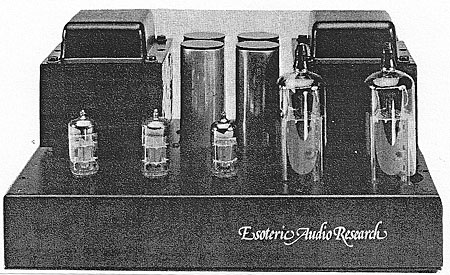| Columns Retired Columns & Blogs |
Tim de Paravicini Page 4
Stereophile: We're looking at a damping factor of only 20, right?
Footnote 1: Actually, the DC resistance of an 8 ohm impedance voice-coil will measure about 5 ohms—but the rest of the argument still holds if you adjust the numbers.—J. Gordon Holt
De Paravicini: Yes, well, it may only appear to have a damping factor of 20 but that needs to be clarified. People have latched on to the idea that damping factor is the only important criterion for tight bass.
Now a conventional dynamic speaker is essentially an electric motor in series with an 8 ohm resistor inside that motor—if you measure the voice-coil terminal it measures 8 ohms DC [(footnote 1)]. Now if you put a screwdriver across those two terminals, you have put an infinite damping factor on that loudspeaker, right?
Stereophile: Right.
De Paravicini: But that electric motor has still got 8 ohms in series with it to damp its motion. It hasn't really got a short circuit. Now, if instead of the screwdriver I put an 8 ohm resistor across those terminals, that electric motor now sees 16 ohms in a series, so in fact it's got half the damping that it had before, which is expressed as a DF of 2. If we lower that resistor from 8 ohms to 1, for example, we now have a damping factor of 8. That electric motor is now seeing 9 ohms, which is only 10% larger than 8 ohms. We're closing the gap towards that perfect 8 ohm resistor, so if we go downwards from below 1 ohm to ½ and then ¼ ohm, we're getting ever closer to that 8 ohm minimum. It just doesn't buy you anything, because you can't get below 8. So if you increase the amplifier's damping factor beyond 10, the actual damping on the speaker remains for all intents and purposes unchanged. Whether you have a damping factor of 1000 or 100,000, the speaker really doesn't know the difference.
Stereophile: Then why is it that amplifiers with very high damping factor usually give the tightest bass?
De Paravicini: The reason amplifiers sound apparently tighter or looser is not their damping factor but the amount and the quality of their feedback and their low-frequency stability under dynamic conditions. The bandwidth, the frequency response, the way it clips, the way it recovers from clipping are all problems that are really of great concern. They are all signatures of the amp's sound characteristics.
The ideal amplifier should recover from an overload infinitely fast and not have any subsonic misbehavior. What I am trying to do is to come as close to that as possible in a transformer-output tube amplifier. That is why my amplifiers may sound as if the bass is thin—simply because there isn't this overhang.
Most tube amplifiers cannot deliver current. They have a rated power into one rated impedance and the minute the impedance deviates significantly on either side of that, their power output goes to pot. I designed the 509 so it would still maintain its rated power down to 3 ohms. It has a peak current capacity—something I don't publish in the specs but that should be mentioned—of 12 amps. That is one of the reasons for the exceptional tightness of the bass. It can keep the speaker under control, and that's why a cheap 10W receiver will often bottom its woofers. The amplifier loses control totally, and you end up with a damping factor of less than 1, momentarily. From a superficially high figure it disappears, then the speaker lets go and it goes back, crash!
Stereophile: How did your own company get started?
De Paravicini: I and a partner formed Esoteric Audio Research with what amounts to about $1000. We built the first pair of 509 amplifiers, sold them, and went on from there.

Stereophile: Which brings us up to the present time. You have other products available now. How would you say your design philosophy is different from those of other companies in the field?
De Paravicini: I feel that the other companies in the tube field are tending to follow each other in their approach to circuitry and performance. I have tried to be different and go off in a completely different direction. Most of these companies' products appear to be variations on a theme, like Paganini's. Although they do have better products than they had 30 years ago, they are all evolutionary developments from earlier products; the topologies and the basic principles inside them have remained the same. They only have small improvements in such things as more generous power supplies. But they haven't dealt with the severe deficiencies in the designs—the behavior of bass and overload recovery, feedback, and a myriad other problems. So in other words, their designs are not all that different from amplifiers made in the 1950s and '60s.
Stereophile: Are you implying a lack of real talent for innovation in the industry?
De Paravicini: Sure. Most of them are probably college dropouts or engineer dropouts or what have you. People who haven't been into audio from childhood and haven't spent all their working life in the industry. A lot of them were hobbyists who made their hobby into a business.
Stereophile: Where are the talented people going, then? What fields do they go into?
De Paravicini: It's a sad fact that the talented people often take the money route and go into the industries that pay the megabucks. Computers, video games, etc.
Footnote 1: Actually, the DC resistance of an 8 ohm impedance voice-coil will measure about 5 ohms—but the rest of the argument still holds if you adjust the numbers.—J. Gordon Holt
- Log in or register to post comments




































